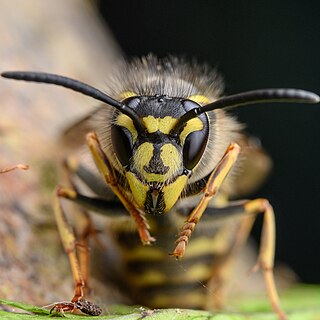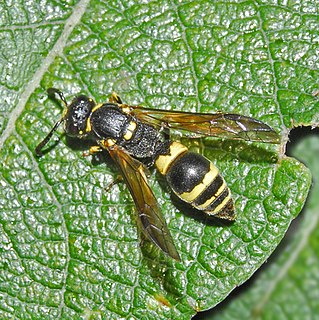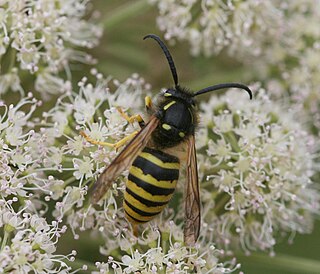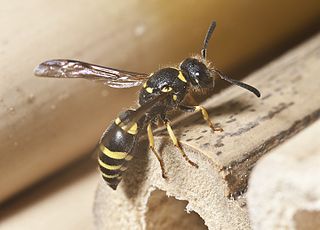
Sawflies are the insects of the suborder Symphyta within the order Hymenoptera alongside ants, bees and wasps. The common name comes from the saw-like appearance of the ovipositor, which the females use to cut into the plants where they lay their eggs. The name is associated especially with the Tenthredinoidea, by far the largest superfamily in the suborder, with about 7,000 known species; in the entire suborder, there are 8,000 described species in more than 800 genera. Symphyta is paraphyletic, consisting of several basal groups within the order Hymenoptera, each one rooted inside the previous group, ending with the Apocrita which are not sawflies.

Vespula vulgaris, known as the common wasp, is found in regions that include the United Kingdom, Germany, India, China, New Zealand and Australia. It is sometimes known as the European wasp, but the same name is used for the species Vespula germanica or German wasp. Another name for Vespula vulgaris is the common yellow-jacket. In 2010, the ostensible Vespula vulgaris wasps in North America were found to be a different species, Vespula alascensis.

Osmia lignaria, commonly known as the orchard mason bee or blue orchard bee, is a megachilid bee that makes nests in reeds and natural holes, creating individual cells for its brood that are separated by mud dividers. Unlike carpenter bees, it cannot drill holes in wood. O. lignaria is a common species used for early spring fruit bloom in Canada and the United States, though a number of other Osmia species are cultured for use in pollination.

Potter wasps, the Eumeninae, are a cosmopolitan wasp group presently treated as a subfamily of Vespidae, but sometimes recognized in the past as a separate family, Eumenidae.

Philanthus triangulum, commonly known as the European beewolf, bee-killer wasp or the bee-eating philanthus, is a solitary wasp that lives in the Western Palearctic and Afrotropics. Although the adults of the species are herbivores, the species derives its name from the behaviour of the inseminated females, who hunt Western honey bees. The female places several of its paralysed prey together with an egg in a small underground chamber, to serve as food for the wasp larvae. All members of the genus Philanthus hunt various species of bees, but P. triangulum is apparently the only one that specialises in Western honey bees.

A wasp is any insect of the narrow-waisted suborder Apocrita of the order Hymenoptera which is neither a bee nor an ant; this excludes the broad-waisted sawflies (Symphyta), which look somewhat like wasps but are in a separate suborder. The wasps do not constitute a clade, a complete natural group with a single ancestor, as their common ancestor is shared by bees and ants. Many wasps, those in the clade Aculeata, can sting their insect prey.

Symmorphus is a primarily holarctic genus of potter wasps.

Colletes hederae, the ivy bee, is a species of plasterer bee belonging to the family Colletidae subfamily Colletinae.

Isodontia mexicana, the Mexican grass-carrying wasp, is a species belonging to the family Sphecidae. It is mainly found throughout North America, but has become established in Europe, primarily France, Switzerland, Hungary, Italy, Serbia, and Spain.

The tree wasp is a species of eusocial wasp in the family Vespidae, found in the temperate regions of Eurasia, particularly in western Europe. Despite being called the tree wasp, it builds both aerial and underground paper nests, and can be found in rural and urban habitats. D. sylvestris is a medium-sized wasp that has yellow and black stripes and a black dot in the center of its clypeus. It is most common to see this wasp between May and September during its 3.5 month colony cycle.

Polistes biglumis is a species of social wasp within Polistes, the most common genus of paper wasp. It is distinguished mainly by its tendency to reside in montane climates in meadows or alpine areas. Selection pressure from the wasp's environment has led to several idiosyncrasies of its behavior and life cycle with respect to its relative species in the genus Polistes. It alone among paper wasps is often polyandrous. In addition, it has a truncated nesting season that gives rise to unique competitive dynamics among females of the species. P. biglumis wasps utilize an odor based recognition system that is the basis for all wasp to wasp interaction of the species. The wasp's life cycle is highly intertwined with that of Polistes atrimandibularis, an obligate social parasite wasp that frequently invades the combs of P. biglumis wasps.

Delta emarginatum is a species of potter wasp in the subfamily Eumeninae of the family Vespidae.

Katamenes arbustorum is a species of potter wasp in the subfamily Eumeninae of the family Vespidae.

Crabro cribrarius, common name slender bodied digger wasp, is a species of wasp of the family Crabronidae.

Ancistrocerus nigricornis is a species of potter wasp.

Symmorphus allobrogus is a species of potter wasps belonging to the subfamily Eumeninae.

Eumenes dubius is a species of potter wasp in the subfamily Eumeninae of the family Vespidae.

Leucospis dorsigera is a species of wasp belonging to the family Leucospidae.

Ancistrocerus longispinosus is a species of potter wasp, belonging to the family Vespidae, subfamily Eumeninae.




















